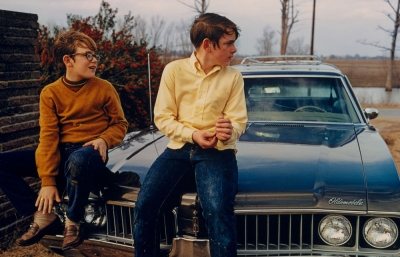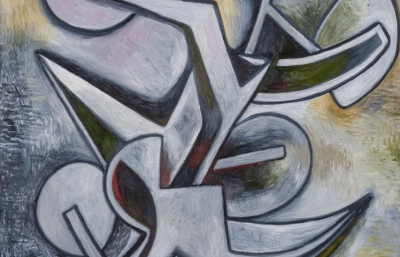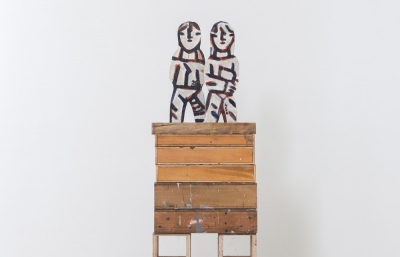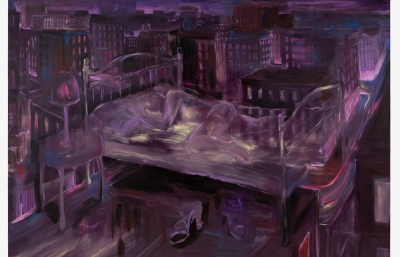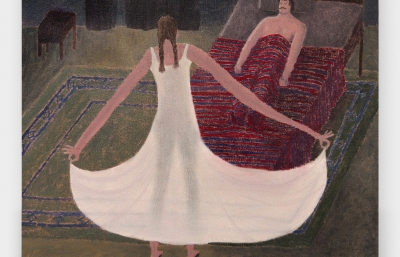Ben Brown Fine Arts is delighted to announce an exhibition of new paintings by Rebecca Ness, marking the first presentation of work by the acclaimed New York-based figurative painter with the gallery. Ness is a painter of everyday life. Her subject matter is people – encountered directly, but also through the environments, objects, and ephemera that surround and define them. At heart a narrative painter, Ness composes tightly constructed mises en scènes, scattered with visual cues and charged with latent stories. Her works are technically virtuosic, formally complex, and driven by a vivid, unapologetic sense of self.
Though strikingly lifelike, Ness’s paintings resist photorealism. She does not prioritise exact representation or strict adherence to scale and perspective. She revels in the materiality of oil paint – brushstrokes are visible, gestures intentional, and the surface always alive. In doing so, Ness aligns herself with a lineage of figurative painters, drawing resonance from David Hockney, Norman Rockwell, and most notably, Lucian Freud.
Painter’s Chair (2025) was created after a visit to Freud’s London studio. It captures smeared paint, used tubes, stained furniture – conjuring Freud’s presence through absence. Ness paints his paint, in his manner, on her terms. The work becomes a reflexive homage, a study in influence, artistic lineage, and the complexities of inheritance. It offers a clear view of the intelligence and wit that underpin her practice.
Ness is an inheritor of the canon of oil painting within Western art history. She works in counterpoint to her predecessors, taking up their mantle while asserting her own identity within the conventions of the discourse. Where Freud was known for his froideur—famously remarking that he treated the head as “just another limb”—Ness adopts an opposing approach. In Kelley (2025), she lingers on the body, luxuriating in tonal shifts and anatomical detail. The cool blue undertones and translucent veins nod to Freud, but the technique is retooled and overlaid with her own lived experience. Her sitters— drawn from her own life—are not objects but subjects, rendered with tenderness and specificity.
Rockwell painted an idealised mid-century America, capturing its coded hierarchies and concealed assumptions. Ness, by contrast, paints her own world – queer, contemporary, and emotionally charged. Her sitters – friends, partners, members of her Brooklyn community – occupy the canvas with a centrality historically reserved for the canonical subjects of Western art.
A recent personal loss lends a poignant undercurrent to this body of work. In Talking to Mom (2025), part of a series reflecting on her mother’s passing, Ness paints herself walking the streets of Brooklyn, in quiet communion with memory. These works, while deeply personal, demonstrate her enduring attention to detail and her ability to universalise grief through visual language.
Ness’s work is informed by British art, particularly David Hockney’s investigations into photography and perspective. Like Hockney, she destabilises the single-point view, constructing compositions from oblique or improbable angles that foreground the act – and politics – of looking. In Talking to Mom, the viewer is positioned in an almost voyeuristic crouch, forced into a vantage point that feels both intimate and intrusive. A glowing white traffic light flickers in the corner, anchoring the reverie in the unsentimental now. The painting recalls a film still suspended in time, charged with the quiet unease of psychological distance. Like Hockney, Ness renders everyday life uncanny – not through distortion, but through precision.
In this body of work, Ness asserts her place within a tradition that has historically excluded voices like hers. With forensic clarity and psychological acuity, she reconfigures the canon through the lens of her own identity, community, and cultural moment. Ness doesn’t just ask us to look, but to truly inhabit – and to feel the strange, vulnerable, funny, and fiercely real humanity in everything we find there.

